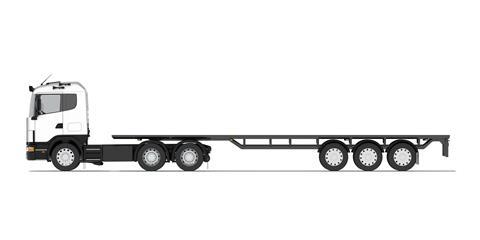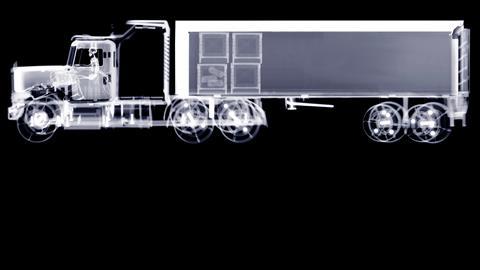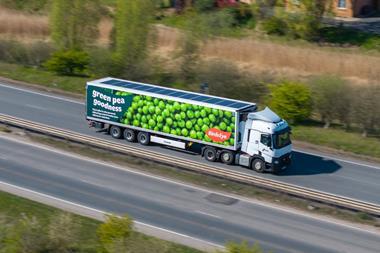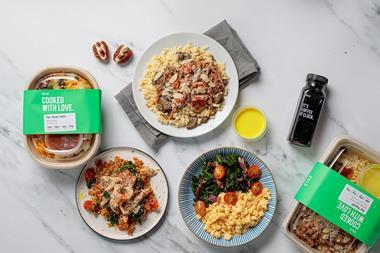One in three lorries on the road are empty, a startling figure of both major financial and environmental cost. So why is it proving so hard to fix?
It’d be easy to assume that the endless stream of lorries ploughing along on the inside lane of Britain’s motorways are all carrying something somewhere. Muffins to Bradford. Pork to Cardiff. Furniture to Stoke. But that’s far from the case. For all the efforts made by businesses to boost efficiencies and cut carbon emissions in recent years, one in three lorries on Britain’s roads is still empty, according to figures from the Department for Transport (DfT), a startling figure with eye-watering consequences for the balance sheets and net-zero ambitions of the sector.
Because what it amounts to is over three billion empty miles of travel by heavy goods vehicles (HGVs) each year, says the DfT, the equivalent of driving to the moon and back 6,500 times. If a single lorry were to carry this journey out, it would take over 5,000 years. Not to mention a fair few litres of diesel.
The positive news is that there is now a concerted effort to tackle the problem, with everyone from haulage giants to innovative startups working to cut down these empty miles. The downside is that many of the problems are complex, in some cases baked into a food supply chain that has grown ever leaner in recent decades. There is also some powerful resistance to change, with some manufacturers finding that despite their efforts to make improvements, they often encounter supermarkets unwilling to play ball.
Ever since Tesco introduced the idea of just-in-time in the 1980s – more frequent deliveries of smaller quantities – Britain’s supply chains have become ever faster. These days, lorries are often arriving at distribution centres every minute of every day, fitting into tight schedules designated by supermarkets.
Hypothetically, in a highly optimised system, whenever a lorry travelled from, say, a factory in Manchester to a supermarket’s DC in Birmingham, the ideal situation would be for it to pick up another load to travel back to Manchester with. The problem for food manufacturers is they often don’t have the luxury of waiting around for an empty lorry to carry their load. “If you only use empty legs then you will only get your load picked up when the truck is finished doing whatever it was doing before you,” says James Wroath, Wincanton CEO. “And if you’re an fmcg supplier into the supermarkets, you don’t get the luxury of delivering it whenever you like.”
“If you’re an fmcg supplier into the supermarkets, you don’t get the luxury of delivering whenever you like”
James Wroath, Wincanton CEO
Wincanton’s own empty lorry rate is between 25% to 30%, Wroath confirms. Not that he blames the supermarkets. “The whole distribution network for supermarkets works on the basis of very sensitive timing. And all of that is generated by consumer demand, which wants a huge range of products and wants them there as efficiently as possible,” Wroath adds. “The trade-off between cost – both environmental cost and financial cost – and service is quite a delicate one.”
As it stands, supermarkets are typically more efficient when bringing goods from their warehouses to stores. This is because in most cases there is something there waiting for them to pick up, whether it be used packaging or empty roll cages. The much bigger question – and therefore opportunity for improvement – is how the number of empty trucks from manufacturers delivering to DCs can be reduced.
In some ways, the situation is a product of the UK’s small size. Take the US or Europe, where distances are significantly further, meaning if you’re delivering from a factory in Warsaw to a distribution centre in Naples, finding a load for the return journey is essential if you’re to avoid exorbitant costs.
In the UK, by contrast, a trip from Birmingham to Manchester is less than 100 miles. If a customer expects delivery in an allotted half-hour time period, many businesses conclude that even if they must return empty, that cost is negligible in the grand scheme of things. It’s one reason why the EU has a slightly more reasonable empty lorry rate of one in five.

Fleet ownership
This proximity has also created a structure in the UK where haulage companies own more of their own fleet than you’d see anywhere else in the world, according to Wroath. As a result, “we’ve never really had a domestic brokerage market”, he adds. Domestic brokerage markets have long dominated haulage in the US, where journeys are sold individually by a brokerage house which holds relationships with thousands of truckers to connect them with a business for each load. With the rise of the internet and mobile technology, the market has easily digitised and developed to create the same system online.
“It will mean many, many millions of pounds worth of savings without even having to change much”
Jack Fleming, Chill Chain founder
In the UK, on the other hand, such a system has never needed to exist. Now though, in search of efficiencies, it is a model many are trying to find. The idea is that by creating a transparent system for both hauliers and businesses, it will make it easy to bring together HGV drivers looking to fill empty journeys, and businesses looking for a driver to carry their load. This in turn will drive huge efficiencies and drastically cut the number of empty lorries on the road.
Lightbulb moment
In 2020, Zeus was launched to do just that. Founders Jai Kanwar and Clemente Theotokis were friends at university when they began looking in detail at the haulage industry. “We very quickly realised just how inefficient it was,” says Kanwar.
One of the main causes they discovered was that the industry is dominated by trucking companies with just a handful of trucks, who in many cases find it difficult to get consistent, recurring work. “Their main source was via contacts,” Kanwar explains. “So their friend or their brother would call and say: ‘Look, I have a job for you. If you have an empty truck, can you pick it up?’ And this is really the reason why trucks, especially in the UK, are running empty. The whole industry is working off very traditional, non-digital ways of working.”
A lightbulb moment came for the duo when speaking to a trucking company in the Midlands with around 35 trucks. “They had technology in their office,” says Theotokis. “They had projectors, they had desktops, they had tech in general. But they were still working off a blackboard to decide which truck would pick up which load with which driver. And that is ultimately then a problem with transparency and access to work for these trucking companies.”
Kanwar and Theotokis set out to solve the problem by building a platform that would connect hauliers in real time to local businesses in need of transportation. They now have 60 multinational clients on their platform – including AB InBev, P&G and Kellogg’s – each with access to around 13,000 trucks. “We’re able to aggregate the demand and supply and give routes to those smaller trucking companies from these large blue-chip customers,” says Theotokis. “And because of that, the percentage of time their trucks run empty reduces.”
31%
of HGVs are empty
3 billion
miles of empty travel
60%
average capacity when a lorry is filled
18%
of road transport emissions are HGVs
5.2
average fleet size in the UK
Source: Department for Transport (2021)
Zeus has raised £4.3m since launching in 2020, money that has been used to develop its technology and expand its customer base. But there are a few question marks within the industry whether it might have overstretched itself. “They’ve done a load of work with P&G and have promised them the earth. But basically now they’re having to buy transport in at a rate far higher than P&G are willing to pay,” says one informed source. “Anyone who works with P&G knows they’re absolute sods to deal with because they don’t care about anything apart from cost.”
It’s a charge Zeus pushes back on. Kanwar says P&G UK makes up “a small portion” of Zeus’s volumes, and partners on European routes “that take full advantage of our low-carbon sustainable transport options”.
While Kanwar accepts subsidising rates does sometimes take place “to unlock long-term gain”, he insists this is the exception and not the rule. Service levels, meanwhile, he says, are “for most of them north of 99%”.
Zeus and its fellow competitors are undoubtedly making their presence felt in the world of logistics. Alongside Zeus’s capture of major players like P&G, 3T caught the eye last year when it won the contract for Heinz’s distribution, ending the food manufacturer’s 25-year relationship with Wincanton, thanks to its “technology-driven approach to vehicle optimisation”.
Meanwhile, Chill-Chain, having built a similar platform to Zeus in 2018 aimed specifically at reducing the amount of empty refrigerated lorries on the road, is now going one step further to try and tackle the problem.
Rather than solely connecting food manufacturers to hauliers, Chill-Chain is now focused on building supplier collaboration to allow a group of manufacturers in a similar region to transport their goods together in a single lorry to a supermarket distribution centre.
“The whole industry is working off very traditional, non-digital ways of working”
Jai Kanwar, Zeus founder
This looks straight into the eye of the other major problem in haulage efficiency. For not only are a third of lorries empty on the road, official figures show even those lorries carrying goods are only 60% full.
Using data it has compiled on how food is moved around the UK, Chill-Chain plans to give manufacturers insights to collaborate with other businesses nearby. Founder Jack Fleming argues this will boost the number of pallets carried in each lorry, meaning “many, many millions of pounds worth of savings without even having to change much”.
Most importantly, “this isn’t even like dropping in a new invention. All the things that enable this they already do, they just don’t collect the data for it.”
One of the big four supermarkets is now in late-stage talks with Chill-Chain over implementing the technology, with internal estimates by the retailer suggesting it could cut up to 12% of its Scope 3 emissions from transport. But such change inevitably upsets someone. As Fleming acknowledges, hauliers themselves are wary this could lead to less work, although he counters they will in fact be getting more profitable work.
But it is not just hauliers nervous about such change. Supermarkets too are posing problems. Food manufacturers across the country are trying to cut emissions and save money by taking vehicles off the road – both by collaborating more with other suppliers and by encouraging retailers to allow a single lorry to drop off goods at numerous supermarkets during the same trip – but are encountering some resistance as a result.
“Unfortunately this is creating tension with the large retailers,” says the head of supply chain at one major food manufacturer. “Some are a bit more enlightened than others but, mostly, they’d like me to go away.”
‘Very territorial’
Supermarkets’ problem with collaboration between suppliers to reduce the number of lorries on the road is that, in many cases, the primary distribution that brings goods from a factory to a DC is a valuable revenue stream for supermarkets. They act as a broker between haulage companies and food manufacturers, meaning if fewer loads are needed, supermarket incomes would suffer.
When it comes to the idea of one lorry dropping at several retailers, the objections are typically more emotive. “They’re very territorial,” the source says. “I can understand why they might be sensitive about a Tesco lorry turning up at a Waitrose. But that’s happening already. They just don’t know it.”
The consequence, they conclude, is that “some of what we do might have to be by stealth”. This would entail grouping together loads for several supermarkets and simply not telling the retailers. It’s hardly an ideal situation, but for some it feels like the only option.




















No comments yet